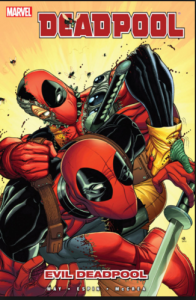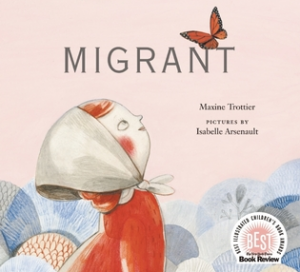A Literary Analysis by Keenan
A. Citation/Bibliographic Entry
- Way, Daniel. Deadpool: Evil Deadpool. New York: Marvel Characters Inc., 2011.
B. Reliability
- I know this author to be reliable because he received the Xeric Foundations Grant in 2000 for his first publication, Violent Lifestyle #1. Through this book, he was introduced to Marvel Comics editor Axel Alonso who hired him for his next mini-series. I also know he is reliable because he went on to write more than 17 comics for Marvel before writing this book, and he continues to write for Marvel today.
C. Category
- The category of this story is Interlocking Episodes because this book has multiple stories about different things. These stories are all about Deadpool and fighting crime. Some graphic comics about Deadpool have a lot of gore but some only have a little bit of gore. The books with a lot of gore are the books that are longer but the ones with alot of gore are shorter than the ones with less gore. The word gore means bloody and violent. These books are not all bloody and violent; they are also funny. The are funny because Deadpool makes so many jokes. One of the jokes he made is “ I got the guns” referring to his muscles. In conclusion, this book’s category is Interlocking Episodes because this book has multiple stories within the same book.
D. Short Annotation
- Deadpool is a middle-aged Superhero from New York who has to convince the NYPD and Captain America that there is a clone of himself causing mischief. This 123-page graphic novel, written from the 1st person point of view, shows the struggle to convince someone that something is true when there is little proof. Recommended for readers 12 – 15 years old.
E. Point of View: 1st person point of view
- “…I just escaped from a mental institution an’ all…” (3).
- “Yep! ’cause I’m a baller like that” (20).
- “I wasn’t lost” (54).
F. Tense: Present
- “Today, I want something on my desk this afternoon” (59).
- “…he recently escaped from a British Maximum Security Prison” (69).
- “…we’ve been monitoring Deadpool’s movements via satellite for the past seventy-two hours” (72).
G. Literary Excellence
- Repetition:
- “Ting, Ting” (114).
- “Brakka, Brakka” (103).
- “Bip – Bip – Bip – Bip – Bip – Bip” (98).
- “Klik – Klik, Klik” (30).
- “Blam, Blam, Blam, Blam, Blam, Blam, Blam, Blam” (29).
- Alliteration:
- “…busting binge begin” (19).
- “…time trying…” (26).
- “…try to…” (33).
- “…won’t, just wanna…” (54).
- Hyperbole:
- “We once got lost on an escalator” (54).
- Onomatopoeia:
- “BRRANNNNGGGG” (39).
- “PSST – -!” (89).
- “KRAKK” (93).
- “SSSSSHHNGG” (94).
- “BRAKKA, CHAKKA, CRAKKA” (103).
- “FFWWWOOOOOOMMM” (35).
- “KKRRROOOOOOOOOMMMMMM” (80).
- “OOK! EEK-EEK!” (117).
H. Connection
My connection to Deadpool: Evil Deadpool by Daniel Way is text to text and text to world.
This book reminds me of other Marvel books I have read in the past. This Marvel book talks about Deadpool and how he convinces the NYPD and Captain America that there is a clone of himself. I have read multiple books about Captain American and other Marvel characters. Another Marvel book is Deadpool Kills the Marvel Universe. These two books both have humour but they also have alot of violence and blood. In this book there are alot of guns and bombs used. Deadpool threatens that he was going to blow himself up with a child in the car to get Evil Deadpool’s attention. These two Deadpool books remind me of the other Deadpool books.
Evil Deadpool also reminds of the recent killings in France. The reason why this book reminds me of this situation is because there were some deaths in the book as well as in France. The difference between the book and the France killings is that there were only a couple deaths in the book, whereas in France there were hundreds killed. In the book, Deadpool is looked at like a terrorist and Captain American said “you are lying and a terrorist” (47). The killings in France were caused by terrorists. In the book, Evil Deadpool acts like a terrorist and tries to kill people, just like in France. The military and police force are like Superheros, just like Captain America and Deadpool. The military and police are acting like them because they are searching for the terrorists in France so that it doesn’t happen again and no one else gets hurt or killed. Deadpool and Captain America are trying to stop Evil Deadpool from harming people, too. The recent killings in France remind me of this book and how the military and police are acting like Deadpool and Captain America.


